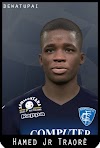EDIT: I don't like this anymore. Find my current system here.
I've been collecting Death and Dismemberment tables since I started this hobby. I've found several I like very much, but none of them quite suit my game.
I've been collecting Death and Dismemberment tables since I started this hobby. I've found several I like very much, but none of them quite suit my game.
Goals
Injuries Before 0 HP
Philotomy's Musings recommends describing all injuries that place below 6 HP as doing physical damage and to describe the rest as "muscles getting tired, sweat getting in [...] eyes, [...] breath running short, [...] resolve weakening, [...] reactions slowing, and [...] reserves of skill and luck being used." This is because, in OD&D, the average person only has 1-6 HP and every weapon does 1-6 damage.Abstract
My favorite Death and Dismemberment Table (from Perdition by Courtney Campbell) is specific to his rules system and also has very specific flavor text such as: "A cut to your chest punctures a lung and makes it hard to breathe." My mind feels limited by such concrete, descriptive sentences. I should feel free to interpret the result as I like, but my imperfect mind has to navigate that wall first.Simple
I've read several Death and Dismemberment tables that I wanted to use but never tried because they were more too complicated. They take too much time to understand and use. I wouldn't feel comfortable handing them to a player without at least a minute of explanation.
Lethal
Odd as it may sound, most Death and Dismemberment tables make it difficult to die. They don't just mitigate death a little, they make it improbable. My table makes it very difficult to roll on it more than once without major consequences.
Credit
A lot of the ideas here, though mostly unrecognizable now, were inspired by Courtney Campbell's fantastic book, Perdition. Perttu Vedenoja made some great suggestions.Death and Dismemberment
When a character's HP is reduced to fewer than 6, roll 1d6 on the Injuries table.At 0 HP, a damaged character must roll 3d6 on the Injuries table. HP cannot drop below 0.
If an Attribute drops to 0, the character dies.
All attribute damage may be recovered as usual unless noted otherwise.
Injuries that are interpreted as severe bleeding or any kind of head trauma cause unconsciousness.
Injuries
| Roll | Effect |
|---|---|
| 1 | -1 to related Attribute (roll on Body Part Table) |
| 2 | -2 to related Attribute (roll on Body Part Table) |
| 3 | -4 to related Attribute (roll on Body Part Table) |
| 4 | -1/4th Movement (foot injury) |
| 5 | -1/2 Movement and knocked to ground (leg injury) |
| 6 | Minor Brain Damage (Roll 1d4 on Brain Damage table) |
| - | Critical Injuries |
| 7 | Severe Brain Damage (Roll 1d4+4 on Brain Damage table) |
| 8 | -10 to related attribute (roll on Body Part Table) |
| 9 | -6 to related attribute (roll on Body Part Table) |
| 10 | Maim/remove body part (save vs CON) |
| 11 | Maim/remove body part (save vs CON) |
| 12 | -6 to related attribute (roll on Body Part Table) |
| 13 | -10 to related attribute (roll on Body Part Table) |
| 14 | Death |
| 15 | Death |
| 16 | Death |
| 17 | Death |
| 18 | Death |
Body Part
Roll 1d4 when appropriate. Reroll if the result does not fit the situation.| Roll | Effect |
|---|---|
| 1 | Head (D6: 1-2 Intelligence 3 Wisdom 4-5 Charisma 6 Blind) |
| 2 | Torso/Groin (Constitution) |
| 3 | Arm (Strength) |
| 4 | Hand (Dexterity) |
Brain Damage
Become unconscious, then save vs Constitution to prevent permanence. (D4 for minor damage and d4+4 for severe damage.)
| Roll | Effect |
|---|---|
| 1 | -1 Intelligence and -1 Wisdom. |
| 2 | -3 Wisdom. |
| 3 | -3 Intelligence. |
| 4 | Save vs lowest Attribute (Wisdom, Intelligence, or Constitution) at the start of battle. Flee on failure. Permanent, no save. |
| 5 | Unable to speak. Permanent, no save. |
| 6 | Change personality and lose one level. Permanent, no save. |
| 7 | Intelligence and Wisdom become 3. |
| 8 | Intelligence is 1. |








0 Comments